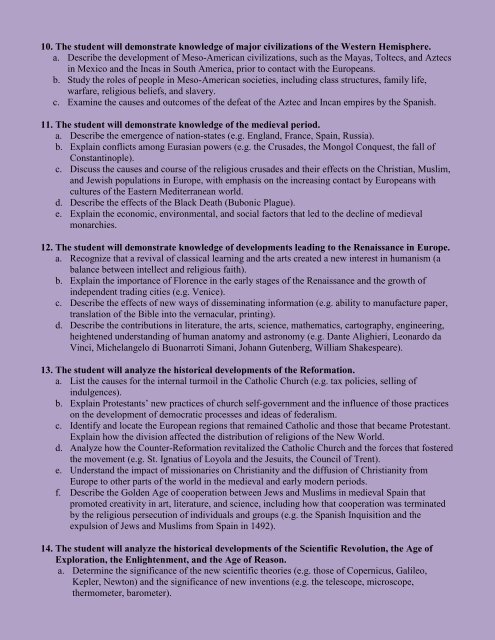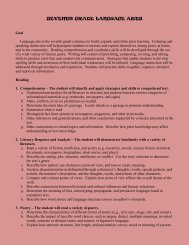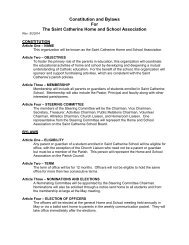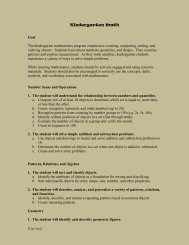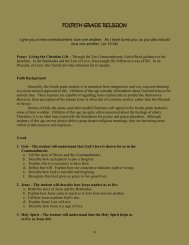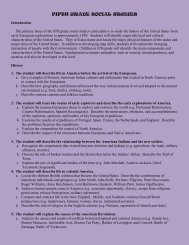SIXTH GRADE SOCIAL STUDIES - Saint Catherine School
SIXTH GRADE SOCIAL STUDIES - Saint Catherine School
SIXTH GRADE SOCIAL STUDIES - Saint Catherine School
You also want an ePaper? Increase the reach of your titles
YUMPU automatically turns print PDFs into web optimized ePapers that Google loves.
10. The student will demonstrate knowledge of major civilizations of the Western Hemisphere.<br />
a. Describe the development of Meso-American civilizations, such as the Mayas, Toltecs, and Aztecs<br />
in Mexico and the Incas in South America, prior to contact with the Europeans.<br />
b. Study the roles of people in Meso-American societies, including class structures, family life,<br />
warfare, religious beliefs, and slavery.<br />
c. Examine the causes and outcomes of the defeat of the Aztec and Incan empires by the Spanish.<br />
11. The student will demonstrate knowledge of the medieval period.<br />
a. Describe the emergence of nation-states (e.g. England, France, Spain, Russia).<br />
b. Explain conflicts among Eurasian powers (e.g. the Crusades, the Mongol Conquest, the fall of<br />
Constantinople).<br />
c. Discuss the causes and course of the religious crusades and their effects on the Christian, Muslim,<br />
and Jewish populations in Europe, with emphasis on the increasing contact by Europeans with<br />
cultures of the Eastern Mediterranean world.<br />
d. Describe the effects of the Black Death (Bubonic Plague).<br />
e. Explain the economic, environmental, and social factors that led to the decline of medieval<br />
monarchies.<br />
12. The student will demonstrate knowledge of developments leading to the Renaissance in Europe.<br />
a. Recognize that a revival of classical learning and the arts created a new interest in humanism (a<br />
balance between intellect and religious faith).<br />
b. Explain the importance of Florence in the early stages of the Renaissance and the growth of<br />
independent trading cities (e.g. Venice).<br />
c. Describe the effects of new ways of disseminating information (e.g. ability to manufacture paper,<br />
translation of the Bible into the vernacular, printing).<br />
d. Describe the contributions in literature, the arts, science, mathematics, cartography, engineering,<br />
heightened understanding of human anatomy and astronomy (e.g. Dante Alighieri, Leonardo da<br />
Vinci, Michelangelo di Buonarroti Simani, Johann Gutenberg, William Shakespeare).<br />
13. The student will analyze the historical developments of the Reformation.<br />
a. List the causes for the internal turmoil in the Catholic Church (e.g. tax policies, selling of<br />
indulgences).<br />
b. Explain Protestants’ new practices of church self-government and the influence of those practices<br />
on the development of democratic processes and ideas of federalism.<br />
c. Identify and locate the European regions that remained Catholic and those that became Protestant.<br />
Explain how the division affected the distribution of religions of the New World.<br />
d. Analyze how the Counter-Reformation revitalized the Catholic Church and the forces that fostered<br />
the movement (e.g. St. Ignatius of Loyola and the Jesuits, the Council of Trent).<br />
e. Understand the impact of missionaries on Christianity and the diffusion of Christianity from<br />
Europe to other parts of the world in the medieval and early modern periods.<br />
f. Describe the Golden Age of cooperation between Jews and Muslims in medieval Spain that<br />
promoted creativity in art, literature, and science, including how that cooperation was terminated<br />
by the religious persecution of individuals and groups (e.g. the Spanish Inquisition and the<br />
expulsion of Jews and Muslims from Spain in 1492).<br />
14. The student will analyze the historical developments of the Scientific Revolution, the Age of<br />
Exploration, the Enlightenment, and the Age of Reason.<br />
a. Determine the significance of the new scientific theories (e.g. those of Copernicus, Galileo,<br />
Kepler, Newton) and the significance of new inventions (e.g. the telescope, microscope,<br />
thermometer, barometer).


